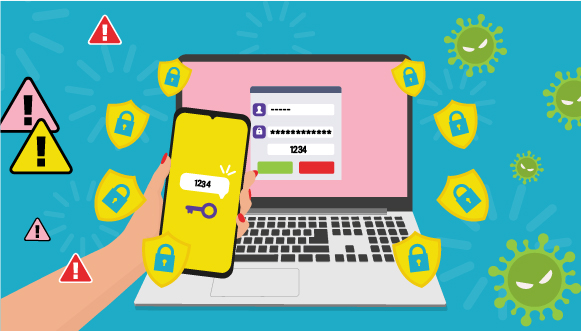
Online accounts make it easier than ever to connect with others, order food in a pinch, watch viral videos, and purchase just about anything you need. Unfortunately, like most things on the internet, they’re also vulnerable to cyber threats. Here are some simple steps you can take to make sure you’re maximizing your account security.
Step 1: create strong passphrases and passwords
The foundation of account security starts with a strong password. That means creating one that is unique from your other accounts. Passwords should be at least 12 characters long including numbers, symbols, and upper- and lower-case letters. To make your accounts even more secure, consider using a passphrase instead. Passphrases include four or more random words, numbers and symbols, and are at least 15 characters long. You should never use personal information (like a pet’s name) that could be easily guessed or found on social media.
Step 2: use a password manager
Now that you have strong and unique passwords and passphrases, you can store them securely in a password manager. Password managers save all your passwords in one encrypted location and can even help you create more complex passwords. That means you only need to remember one master password to access all your accounts. When choosing a password manager, we recommend selecting a free or paid option that isn’t part of your browser’s settings free or paid option. The password manager built into your browser is often less secure (especially if you use a shared device), as anyone that uses your device can gain access to your accounts.
Step 3: enable multi-factor authentication
After creating a strong password or passphrase and storing it in your password manager, it’s time to add an extra layer of security to your accounts. Multi-factor authentication (MFA) does this by requiring an additional step to verify your identity beyond your password or passphrase. This might look like a code sent to your phone or email address, a thumb print, facial recognition, or even a token. According to a report done by Microsoft, Multi-factor authentication is effective at preventing 99% of account related attacks!
Step 4: apply security measures to your social media accounts
Social media is a great place to share memories and life updates, but just like on other platforms, cyber threats exist. Some of this personal information can easily be exploited. For example, using a pet’s name in your password, or using the name of your favourite hockey team as one of your security questions. You can protect your social media accounts by using strong and unique passwords or passphrases, enabling multi-factor authentication, and updating the security settings on your accounts. Consider limiting who can see what you post online by making your account private and blocking people that you don’t know.
Bonus: review and update old accounts
If you have passwords or passphrases that you haven’t updated in a while (or ever), it might be time to. Important accounts that hold critical information like your email or your banking account should be reviewed and monitored regularly. You can ensure that all your accounts have strong, unique passwords as you update your password manager. Regularly updating your account security can help you stay ahead of cyber threats and protect your personal information.
Conclusion
Taking these steps to secure your accounts will help protect your personal information online. By using strong passwords, password managers, and multi-factor authentication (MFA) for all your accounts, you can significantly reduce the risk of cyber attacks!